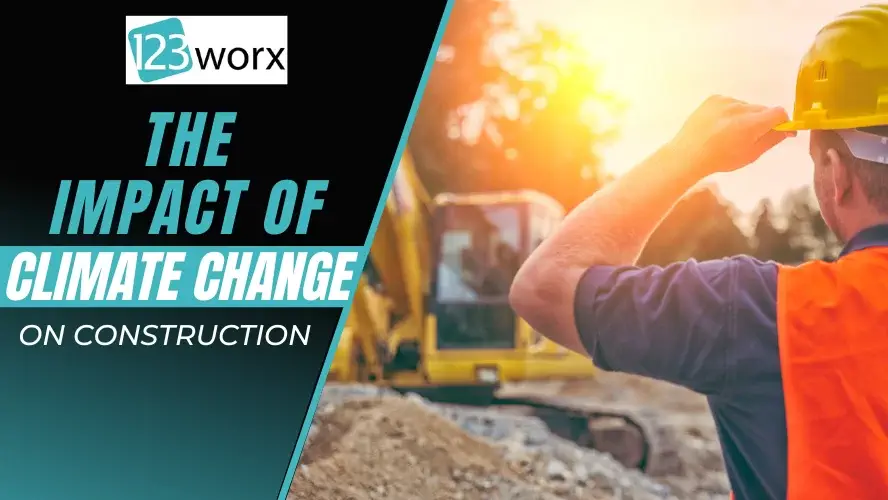Climate change is a topic that has become more important than ever before. Finally, it is getting the attention that was needed decades back.
As the weather pattern started to change it is causing natural disasters at a magnitude never seen in recent recorded history. Every sector is getting the impact of these weather calamities.
The most impact can be seen on the residential, commercial, and public infrastructure leading to hundreds of billions of dollars in harm every year. The ever-higher rising temperature of the heat and natural calamities underscore the critical need for us all to actively pursue and develop revolutionary alternative solutions to the well-trodden conventional construction.
Climate change has disturbed environmental factors and posed a challenge to the durability and longevity of buildings.
Understanding Weatherproof Construction
The most valid alternative exists in weatherproof construction. Weatherproof construction focuses on creating building structures that can resist harsh environmental elements that affect the building’s occupants’ safety and comfort.
This approach involves the use of materials and techniques that prevent the building from excessive wetting, high winds, temperature fluctuation, and related harmful environmental weather risks.
Weatherproof construction goes beyond just insulating or waterproofing a structure; it is the overall understanding of area climatic patterns, wind loads, and other environmental considerations that impact building performance. With the use of weatherproofing features included in the design and the construction process, better resilience and sustainability can be developed.
Benefits of Weatherproof Construction
Weatherproofing comes with lots of advantages both in the long and short term compared to traditional methods of construction.
- First, it will protect the building from water damage, which is the top concern in regions with flood-prone or heavy rainfall.
This will reduce the risk of structural damage, mold growth, and other moisture-related problems ensuring longevity. It highly cuts the cost involved in repairs and maintenance which could be very expensive, saving both time and money for building owners.
- The second one is weatherproof construction boosts energy efficiency.
Weatherproofing construction also reduces the need for heating and cooling by reducing air leakage and heat transfer; hence, the owner has to spend less on energy bills. This is beneficial to the environment in a manner that aids in saving greenhouse gas emissions, but it also allows building owners to save money from what they spend on the energy to run the building.
- Last but not least, the structure is also weatherproof.
This process will, therefore, reduce the dependence of the building on both artificial heating and cooling, reducing the building’s carbon footprint. Moreover, the materials that make up the weatherproof elements can be renewable or recycled, reducing the impact of the construction process on the environment.
Weatherproof Construction Materials and Techniques
In construction, weatherproofing plays a major role in the selection of materials and techniques to be used. Some of the common materials that would be used in weatherproofing include:
1. Weather-resistant coatings: These are applied on the outside surfaces of the building, which works as an additional protection layer against moisture, UV radiation, and others related to weather.
2. Waterproof membranes: These are the thin sheets of materials laid on the roofs, foundations, and other parts that fill the gaps in the building and prevent water, air, or moisture from soaking into the building, thus minimizing the risk of structural damage.
3. High-performance insulation: Insulation is vital for weather-proof construction. It controls room temperature from the inside and stops air from leaking out reducing energy flow. The insulation material also provides sound insulation, contributing to increased comfort for occupants.
4. Impact Resistant Windows and doors: Glass windows and doors are a major concern during storms in weatherproof construction. The use of impact-resistance materials can protect buildings from high winds, flying debris, projectiles, and other hazards.
The building might also be weatherproofed with the use of such materials, in addition to employing construction methods such as proper flashing installation, effective drainage systems, and strategic landscaping.
Design Considerations for Weatherproof Construction
A sound and durable construction against weatherproofing is only possible once and when it involves all the measures of weatherproofing at the design stage itself.
Several factors must be considered by the architects and designers to make the building strong and durable.
- Firstly, the orientation and layout of the building should shield occupants from extreme weather conditions. Optimal positioning for natural ventilation and daylight by proper placing of windows, doors, and other openings minimizes heat gain and wind pressure.
- Second, the choice of materials should be carefully considered. Materials should exhibit high resistance to moisture, temperature drop, and UV damage. Besides, designing interfaces and joints between different materials to prevent water ingress and air leakage is essential
- Lastly, it should include features that promote sustainable practices in the building. The design should incorporate local and renewable energy sources along with rainwater harvesting systems and green roofs to ensure improvement in building efficiency and the minimization of environmental impact.
Incorporating Sustainability into Weatherproof Construction
By the way, sustainability incorporated in the construction process is highly important, aside from being weatherproof. This can be done using these methods:
5. Eco-friendly material: Consider material with low embodied energy, recycled content, and renewal sources that reduce the carbon emission from the building.
6. Energy efficiency systems: This involves the incorporation of energy efficiency features such as solar panels, LED lighting, and smart HVAC and all together reduce the dependence on non-renewable resources in consuming energy.
7. Adopt water-saving measures: Use water-saving features to place fixtures, and install systems for harvesting rainwater and greywater recycling systems to minimize the amount of water in use.
When combined with sustainable practices, these weatherproofing strategies can help make buildings that can stand against natural elements, but most importantly, contribute to a greener, more sustainable future.
Building Codes and Regulations for Weatherproof Construction
Building codes and regulations are important for the acceptance of weatherproof construction. These codes and regulations set the standards for weatherproof measures and ensure that the building has been designed and constructed in such a manner as to withstand local climatic conditions and protect the building elements.
The other typical weatherproofing elements included in the building codes are wind resistance, control of moisture, and insulation, among other controlling measures. In such cases, the buildings are safe, durable, and able to withstand codes.
In some building codes’ requirements, there are standards of sustainability, such as LEED certification, to promote things like energy-efficient practices and using environmentally sound materials.
The Future of Weatherproof Construction
The future for weather element-resistant construction looks bright as long as we continue to address the construction challenges posed by climate change. New research and technologies with advanced science materials and sustainable design practices will further increase the efficacy of weatherproofing.
Self-healing coatings and smart membranes that can adjust to the change of weather are supposed to be part of new weatherproof materials. Additionally, smart building technologies and renewable energy systems together will improve the potential of energy performance and resilience of the weatherproof building.
Besides, the increasing awareness of climate resilience and sustainability is supposed to grow weatherproof construction. Weatherproof construction would be increasingly preferred by the government, organizations, and individuals for saving their investments and adding to the sustainability drive.
Weatherproof Construction is Better – Concluding the Facts
Based on these measures, it can safely be concluded that weatherproof construction has proven as an innovative alternative to traditional construction management solutions in the wake of climate change. It will be possible to build buildings that are resilient, durable, and sustainable.
The problem of climate change has become one of massive concern for architects, designers, and construction professionals. In fact, it is very important to understand the effect of climate change on their field and grasp the implications of weatherproof constructions for their industry.
The use of weatherproofing techniques, materials, and design considerations in a building can greatly increase the strength and durability of that building.
Adding sustainability to weatherproof construction while adhering to building codes and rules has the potential to create a built environment that is weatherproof and eco-friendly.
Further development in technology and growing awareness toward climate resiliency are expected to fuel the growth of weatherproof construction further.
Adopting such innovative measures ensures that the built environment they produce is adaptive to various challenges arising out of climate change.

As a Vice President at 123worx, Construction Management Platform, Bharat Rudra has worked with hundreds of business executives searching for best-suited software for their construction business with a wide array of requirements. Bharat takes pride in helping construction businesses solve their business and project management challenges. Feel free to reach Bharat if you have any questions. You can find him on LinkedIn or reach him at brudra@123worx.com


Recent Comments